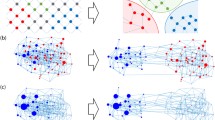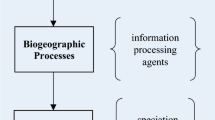Abstract
Many insects produce two types (winged and wingless) of offspring that greatly differ in dispersal ability. The ratio of the two types often depends on the quality of the local habitat and the crowding experienced by the mother. Here we studied the condition-dependent dispersal that is evolutionarily stable. The model is also applicable to annual plants that produce two types of seeds differing in dispersal rates. The model assumptions are: the population is composed of a number of sites each occupied by a single adult. The total number of offspring produced by a mother depends on the environmental quality of the site that varies over the years and between sites. The ESS fraction of dispersing type as a function of the quality of the habitat (or ESS reaction norm) states that dispersers should not be produced if habitat qualitym is smaller than a critical valuek. Ifm is larger thank, the number of dispersers should increase withm and that of nondispersers should be kept constant. Second, we developed an alternative way of searching for the ESS: the reaction norm is represented as a three-layered neural network, and the parameters (weights and biases) are chosen by genetic algorithm (GA). This method can be extended easily to the cases of multiple environmental factors. There was an optimal (relatively wide) range of mutation rates for weights and biases, outside of which the convergence of the network to the valid ESS was likely to fail. Recombination, or crossing-over, was not effective in improving the success rate. The learned network often shows several characteristic ways of deviation from the ESS. We also examined the case in which the quality of different sites was correlated. In this case the ESS fraction of dispersers increases both with the quality of the site and with the average quality of the whole population in that year.
Similar content being viewed by others
References
Arak, A and M. Enquist (1993) Hidden preferences and the evolution of signals.Philosophical Transactions of the Royal Society of London B 340: 207–213.
Aukema, B. (1995) Evolutionary significance of wing dimorphism in Carabid beetles (Coleoptera: Carabidae).Research on Population Ecology 37: 105–110.
Cohen, S. A. and U. Motro (1989) More on optimal rates of dispersal: taking into account the cost of the dispersal mechanism.American Naturalist 134: 659–653.
Comins, H. N., W. D. Hamilton and R. M. May (1980) Evolutionarily stable dispersal strategies.Journal of theoretical Biology 82: 205–230.
Crespi, B. J. and P. D. Taylor (1990) Dispersal rates under variable patch density.American Naturalist 135: 48–62.
Davis L. (1990)Handbook of genetic algorithms, van Nostrand Reinhold, New York.
Denno, R. F. (1994) The evolution of dispersal polymorphisms in insects: the influence of habitats, host plants and mates.Research on Population Ecology 36: 127–135.
Enquist, M. and A. Arak (1993) Selection of exaggerated male traits by female aesthetic senses.Nature 361: 446–448.
Enquist, M and A. Arak (1994) Symmetry, beauty and evolution.Nature 372: 169–172.
Ezoe, H. (1995) Evolutionarily stable seasonal timing for insects with competition for renewable resource.Evolutionary Ecology 9: 328–339.
Fairbairn, D. J. (1994) Wing dimorphism and the migratory syndrome: correlated traits for migratory tendency in wing dimorphic insects.Research on Population Ecology 36: 157–163.
Gatehouse, A. G. (1994) Insect migration —variability and success in a capricious environment.Researches on Population Ecology 36: 165–171.
Geritz, S. (1995) Evolutionarily stable seed polymorphism and small-scale spatial variation in seedling density.American Naturalist 146: 685–707.
Grafen, A. (1990) Biological signals as handicaps.Journal of theoretical Biology 144: 517–546.
Hamilton, W. D. and R. M. May (1977) Dispersal in stable habitats.Nature 269: 578–581.
Holland, J. (1985)Adaptation in natural and artificial world. MIT Press, Boston.
Ishikawa, M. (1990) An adaptive structural learning of connectionist models using forgetting.Journal of Japanese Society for Artificial Intelligence 5: 595–603.
Iwasa, Y. (1991) Sex change evolution and cost of reproduction.Behavioral Ecology 2: 56–68.
Iwasa, Y. and A. Pomiankowski (1994) Evolution of mate preferences for multiple sexual ornaments.Evolution 48: 853–867.
Iwasa, Y., A. Pomiankowski, and S. Nee (1991) The evolution of costly mate preferences. II. The “handicap” principle.Evolution 45: 1431–1442.
Johnstone, R. A. (1994) Female preference for symetrial males as a by-product of selection for mate recognition.Nature 371: 172–175.
Johnstone, R. A. (1995) Honest advertisement of multiple qualities using multiple signals.Journal of theoretical Biology 177: 87–94.
Johnston, V. S. and M. Franklin (1993) Is the beauty in the eye of the beholder?Ethology and Sociobiology 14: 183–199.
Kamo, M., T. Kubo and Y. Iwasa (1997) Neural network for female mate preference, trained by a genetic algorithm.Philosophical Transactions of the Royal Society of London B (in press)
Kawada, K. (1987) Polymorphism and morph determination. pp. 255–268. In A. K. Minks and P. Harrewijn (eds.)Aphids: their biology, natural enemies and control, vol. A. Elsevier, Amsterdam.
Lande, R. (1981) Models of speciation by sexual selection of polygenic traits.Proceeding of National Academy of Science USA 78: 3721–3725.
Liu, S-S. (1994) Production of alatae in response to low temperature in aphids: a trait of seasonal adaptation, pp. 245–261. In H. V. Danks (ed.)Insect life-cycle polymorphism. Kluwer Academic Publ., Dortrecht.
Masaki, S. and T. Shimizu (1995) Variability in wing form of crickets.Research on Population Ecology 37:119–128.
Maynard Smith, J. (1982)Evolution and the theory of game. Cambridge University Press, Cambridge.
Michalewicz, Z. (1994)Genetic algorithms+data structure=evolution programs, 2nd edn. Springer-Verlag, New York.
Olivieri, I., Y. Michalakis and P-H. Gouyon (1995) Metapopulation genetics and the evolution of dispersal.American Naturalist 146: 202–228.
Ozaki, K. (1995) Intergall migration in aphids; a model and a test of ESS dispersal rate.Evolutionary Ecology 9: 542–549.
Pomiankowski, A. and Y. Iwasa (1993) Evolution of multiple sexual ornaments by Fisher’s process of sexual selection.Proceeding of the Royal Society of London B 253: 173–181.
Pomiankowski, A., Y. Iwasa and S. Nee (1991) The evolution of costly mate preferences. I. Fisher and biased mutation.Evolution 45: 1422–1430.
Roff, D. A. (1994a) Why is there so much genetic variation for wing dimorphism?Research on Population Ecology 36: 145–150.
Roff, D. A. (1994b) Habitat persistence and the evolution of wing dimorphism in insects.American Naturalist 144: 772–798.
Roff, D. A. and D. J. Fairbairn (1991) Wing dimorphisms and the evolution of migratory polymorphisms among the insecta.American Zoologist 31: 243–251.
Solbreck, C. (1995) Variable fortunes in a patchy landscape-the habitat templet of an insect migrant.Research on Population Ecology 37: 129–134.
Sumida, B. H., A.I. Houston, J. M. McNamara and W. D. Hamilton (1990) Genetic algorithms and evolution.Journal of theoretical Biology 147: 59–84.
Takeda, Y. (1993) A new analytical method for developmental system and its application to Drosophila dorso-ventral axis formation.Forma 8: 211–232.
Takeda, Y. and Y. Iwasa (1997) A neural network modeling for concentration-dependent pair-rule gene expression.Forma (in press)
Tanaka, S. (1994) Evolution and physiological consequences of dealation in crickets.Research on Population Ecology 36: 137–143.
Toquenaga, Y., I. Kajitani and T. Hoshino (1994) Egret of a feather flock together, pp. 140–151. In R. A. Brooks and P. Maes (eds.)Artificial life. IV. MIT Press, London, UK.
Zera, A. J. and S. Mole (1994) The physiological costs of flight capability in wing-dimorphic crickets.Research on Population Ecology 36: 151–156.
Zera, A. J. and R. F. Denno (1997) Physiology and ecology of dispersal polymorphism in insects.Annual Review of Entomology 42: 207–230.
Author information
Authors and Affiliations
Corresponding author
Rights and permissions
About this article
Cite this article
Ezoe, H., Iwasa, Y. Evolution of condition-dependent dispersal: A genetic-algorithm search for the ESS reaction norm. Res Popul Ecol 39, 127–137 (1997). https://doi.org/10.1007/BF02765258
Received:
Accepted:
Issue Date:
DOI: https://doi.org/10.1007/BF02765258




